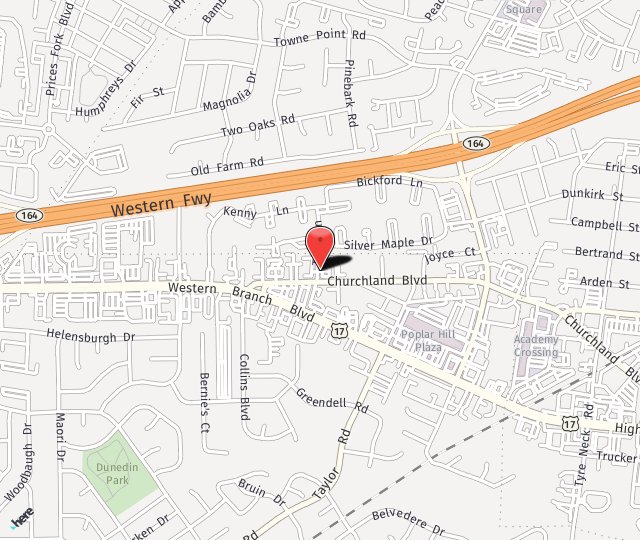Age-related macular degeneration (AMD) is the most common cause of vision loss in individuals over the age of 50. The name of the condition derives from its cause: damage to the macula, the most sensitive spot on the retina, required for clarity in the center of the visual field. The macula transmits electrical signals through the optic nerve to the brain. Damage to the macula results in retinal tissue degeneration that gradually worsens, diminishing or destroying central vision. Get trusted, personalized care for age-related macular degeneration (AMD) at Southside Eye Care, where preserving your vision is our top priority.
The speed at which AMD advances is variable. In some patients, the condition progresses slowly and the changes in vision are imperceptible for some time. In others, the disease moves at an accelerated pace, leading relatively quickly to the loss of central vision in one or both eyes. While AMD does not result in complete blindness because some peripheral vision always remains, it does make ordinary activities, particularly those that require close visual acuity, increasingly difficult.
What Are The Symptoms Of AMD?
Just as there are a number of signs that indicate the presence of AMD to the ophthalmologist, there are a number of symptoms experienced by the patient. Visual symptoms of macular degeneration may include:
- Wavy lines
- Gradual lessening of color perception
- Distorted or blurry vision
- Dimmed vision, especially when reading
- Dark spots in the center of the visual field

In a great many cases of AMD, even when the central field of vision has been lost, patients retain enough visual acuity to navigate their daily lives.
Stages And Types Of AMD
There are three stages of AMD. These stages are designated both by signs detected by the ophthalmologist and symptoms experienced by the patient.
EARLY STAGE AMD
During early AMD, the physician can diagnose the illness by the presence of more than the usual number of drusen, yellow deposits under the retina, These drusen of medium size. Typically, patients with early AMD are not yet experiencing any loss of vision.
INTERMEDIATE STAGE AMD
When a patient is in the intermediate stage of AMD, the doctor observes large drusen as well as possible changes in retinal pigment. While some patients at this stage may experience small gaps in vision, most patients with intermediate AMD do not experience any significant vision loss.
LATE STAGE AMD
During late-stage AMD, patients have enough damage to the macula to experience significant vision loss. The two types of late AMD are:
- Dry, or geographic, in which macula tissue degenerates
- Wet, or neovascular, in which abnormal blood vessels grow
In the wet type of AMD, which progresses more rapidly than the dry, the newly developed blood vessels may leak blood and fluid. Visual loss in dry AMD usually occurs more gradually. Ninety percent of patients diagnosed with AMD have the dry variety, but approximately 10 percent of these patients later develop the wet variety of the disorder. Although patients with either type may experience vision loss, wet AMD not only progresses more rapidly but usually results in greater visual damage.
Macular Degeneration Treatment Options
While there is not yet a cure for AMD, many patients have been helped greatly by recent innovations in treatment. Regular eye examinations to facilitate early detection of AMD are essential since most therapies work best when started at an early stage of either type of the disorder. Even though treatments cannot reverse the disease process, they are often able to stop the progression of symptoms so the patient can maintain as much vision as possible.
Recommended treatments for AMD may include one or more of the following, each of which approaches controlling AMD in a somewhat different way:
- Vitamin and mineral supplementation are known as AREDS
- Injections of anti-VEGF (vascular endothelial growth factor)
- Use of low vision aids
Living with AMD does require certain lifestyle modifications. In addition to having regular checkups to detect any changes in your vision, you should:
- Use Assistive Devices: Some AMD patients may need to use magnifiers to read small print, buy books with larger print, and use watches that have high-contrasting colors for better visibility.
- Optimize lighting: Proper lighting can make it easier to read or cook. Shades can help reduce glare and wear sunglasses.
- Reorganize your home: You can eliminate tripping by removing rugs and clutter.
- Stay active: Having AMD does not mean you need to stop doing activities.
How Is Macular Degeneration Diagnosed?
In order to definitively diagnose AMD, any or all of the following are necessary:
- Visual acuity test
- Physical examination of the back of the eye after dilation
- Amsler grid test for central vision
- Fluorescein angiogram, in which dye highlights the blood vessels
- Optical coherence tomography (OCT)
During the physical examination of the eye, the ophthalmologist takes particular care to look for pigment changes under the retina, as well as for drusen.
Risk Factors For AMD
Individuals over the age of 50 with a family history of the disease are at increased risk of developing AMD. Environmental factors may also increase risk. These include:
- Poor diet
- Lack of exercise
- Smoking
- Excessive exposure to sunlight
- Elevated blood pressure
- Elevated cholesterol levels
Females and people with light skin or eyes are at greater risk of developing this condition.
Why Choose Southside Eye Care
At Southside Eye Care, we are committed to preserving your best possible vision through personalized, high-quality care. Our experienced team, including Dr. Michael Keverline, Dr. Ian Uber, and Dr. Theodore Hallberg, specializes in comprehensive eye care and the diagnosis and management of age-related macular degeneration (AMD). With board certification, decades of combined experience, and a strong focus on patient care, our doctors offer expert treatment in a compassionate environment.
We also take pride in our skilled, JCHAPO-supported technicians who assist in delivering attentive, efficient care. In addition to AMD services, we offer a full range of eye care options—including glaucoma treatment, diabetic eye exams, and routine care—all under one roof. Our in-house Optical Shoppe adds convenience with a wide selection of high-quality frames and lenses guided by licensed opticians. At Southside Eye Care, your vision and comfort come first.
Frequently Asked Questions
Is AMD hereditary?
Yes, AMD can have a genetic component. If you have a family history of AMD, your risk is higher. However, certain lifestyle factors, like smoking, diet, and sun exposure, also play a role in its development.
Is AMD painful?
No, AMD is not a painful condition. It affects central vision gradually or suddenly, depending on the type (dry or wet), but it does not cause physical pain in the eyes.
Can AMD affect both eyes?
Yes, AMD can affect both eyes, although it may not progress at the same rate in each. Some individuals may notice symptoms in one eye before the other is affected.
How often should I get my eyes checked if I have AMD?
If you've been diagnosed with AMD, you should see your eye doctor at least once a year, or more frequently if advised. Regular monitoring is essential to catch any progression early, especially the transition from dry to wet AMD.
Are AMD injections painful?
Most patients report only slight discomfort or pressure during AMD injections. Numbing drops are used beforehand to ensure the treatment is as comfortable as possible.
How often will I need injections for wet AMD?
The frequency of injections varies by individual and the medication used. Typically, injections are given monthly or every few months initially, and may be spaced out over time based on your response to treatment.
What foods are good for AMD prevention?
A diet that includes leafy greens (like spinach and kale), colorful fruits and vegetables, fish high in omega-3s (like salmon), and nuts can support eye health. These foods provide antioxidants and nutrients like lutein, zeaxanthin, and zinc that may help reduce AMD risk or progression.
Will I still be able to drive with AMD?
Driving ability depends on how advanced your AMD is and how much it affects your central vision. Many people with early-stage AMD can still drive safely, but regular eye exams are essential to ensure your vision meets legal and safety requirements.
How do I know if my AMD is getting worse?
Signs that AMD may be worsening include increasing blurriness in central vision, difficulty reading or recognizing faces, or the appearance of straight lines that look wavy (a symptom of wet AMD). Report any changes immediately.
How fast does AMD progress?
The progression rate of AMD varies. Dry AMD typically advances slowly over several years, while wet AMD can develop rapidly and lead to more significant vision loss if not treated promptly.
Protect Your Sight with Expert AMD Treatment in Chesapeake, VA
There are always advancements being made in the world of medicine. As such, you should stay on top of the changes. Ask your ophthalmologist about any new developments and whether you are a candidate for them.
Southside Eye Care proudly serves Chesapeake, Norfolk, Portsmouth, Suffolk and Virginia Beach Virginia as well as the surrounding areas. For more information on Age-Related Macular Degeneration call us at 757-484-0101 today or fill out our contact form for more information.

